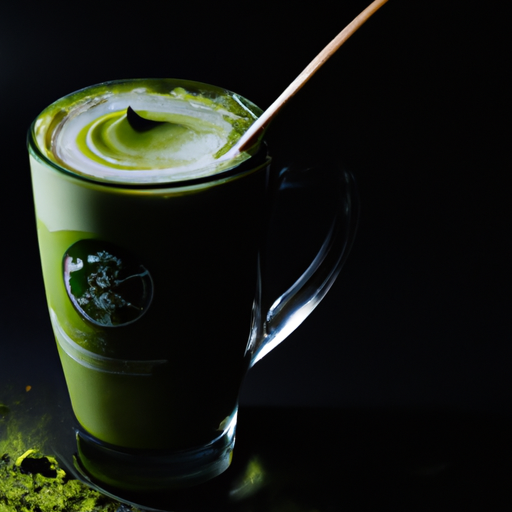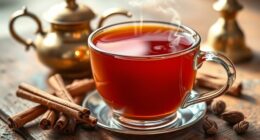Have you ever pondered the reasons behind matcha’s high cost?
As a lover of this vibrant green tea, I’ve often found myself pondering this question.
Matcha has become increasingly popular in recent years, with its bright color and unique flavor making it a favorite among tea enthusiasts and health-conscious individuals alike.
But what exactly makes this tea so valuable?
To answer this question, we need to delve into the world of matcha cultivation and production.
There are a variety of factors that contribute to the high cost of matcha, from the strict quality control standards to the environmental factors that impact the tea’s flavor and aroma.
In this article, we’ll explore the reasons behind matcha’s high price tag and gain a deeper understanding of this beloved tea.
Key Takeaways
- Matcha’s unique taste, color, and health benefits, as well as its time-consuming and labor-intensive cultivation process, contribute to its high price.
- Factors affecting matcha’s price include quality control standards, import tariffs, environmental factors, age of tea plants, location of the farm, time of harvest, quality of shading process, and grinding method.
- Sustainable farming practices and fairtrade and organic certifications are important considerations in the production of high-quality matcha.
- The matcha industry must prioritize social and environmental responsibility for long-term sustainability, while also considering market factors such as competition, technology, and consumer education.
Overview of Matcha and Its Popularity
You’ve probably heard of matcha, the trendy green tea powder that’s taking the world by storm. Matcha has become popular due to its unique taste, beautiful green color, and numerous health benefits.
Matcha is made from shade-grown tea leaves that are ground into a fine powder. The tea leaves are grown in Japan, where matcha has been a staple for centuries. Matcha has many health benefits, including high levels of antioxidants and anti-inflammatory properties. It also contains caffeine and L-theanine, which can improve focus and alertness while promoting relaxation.
Matcha is also versatile and can be used in a variety of culinary applications, such as adding it to smoothies, baked goods, and even savory dishes like soups and marinades. Despite its popularity, matcha can be quite expensive.
This is due in part to the time-consuming and labor-intensive cultivation process. The tea leaves used to make matcha are grown in the shade for several weeks before being harvested by hand. This increases the chlorophyll content and creates a vibrant green color. The leaves are then dried, deveined, and ground into a fine powder using traditional stone mills.
All of these steps require specialized equipment and skilled labor, which contributes to the high cost of matcha.
Matcha Cultivation Process
During the cultivation process, farmers meticulously shade the tea leaves to increase chlorophyll production. This process typically takes around three weeks and is essential to creating the vibrant green color that matcha is known for.
Once the leaves have reached the desired level of chlorophyll, they are harvested and quickly steamed to halt any oxidation. After the steaming process, the leaves are dried and the veins and stems are removed. This is known as the tencha stage and is where the leaves are ground into the fine powder that we know as matcha.
The grinding process is done slowly and carefully to prevent the powder from overheating and losing its flavor. Harvesting techniques and processing methods play a significant role in the final product’s quality and price. Here are five factors that can influence the cost of matcha:
- The age of the tea plants
- The location of the farm
- The time of the harvest
- The quality of the shading process
- The grinding method
Matcha’s high price is partly due to the amount of work that goes into its cultivation and processing. However, the quality control standards also play a crucial role in determining the price. In the next section, we’ll explore the rigorous standards that matcha must meet to be considered high-quality.
Quality Control Standards
Maintaining high quality standards is crucial in ensuring that consumers get the best possible matcha experience. Quality assurance practices are implemented by matcha farmers to ensure that only the highest quality leaves are used in the production of matcha. These practices include careful selection of tea plants, proper shading, and picking only the youngest and most tender leaves.
In addition to quality assurance, import tariffs on matcha also contribute to its high cost. The process of importing matcha into different countries involves taxes and duties, which are then passed on to consumers. These tariffs can significantly increase the price of matcha, making it more expensive compared to other types of teas.
Despite the high cost of matcha, consumers are willing to pay for the quality experience it provides.
In the next section, we will discuss how environmental factors such as weather and soil quality affect matcha cultivation and contribute to its unique taste and aroma.
Environmental Factors
When it comes to matcha, the environment plays a crucial role in determining its quality and price. As someone who’s studied the tea industry, I can tell you that matcha is grown in only a few limited regions of Japan, which contributes to its exclusivity and expense.
The climate and soil conditions of these regions are also essential in producing high-quality matcha. That’s why sustainable farming practices are crucial for maintaining the integrity of the crop.
Limited Growing Regions
Matcha’s high price can be attributed to its limited availability. It’s only grown in select regions with the ideal climate and soil conditions for the tea plant. This means that the production of matcha is heavily dependent on geography, which can lead to various factors that drive up its price.
For instance, changes in weather patterns, natural disasters, and other environmental events can cause price fluctuations in the market. Additionally, matcha is a labor-intensive crop that requires a significant amount of care and attention throughout the cultivation process. This further adds to the cost of production.
To underscore this point, here are some nested bullet point lists to highlight the specific reasons why matcha is expensive due to its limited growing regions:
- Limited availability: Matcha is only grown in a few regions, which means that the supply is limited and demand can easily outstrip it.
- High transportation costs: Due to the limited growing regions, matcha must often be transported long distances, which adds to the cost of production.
- High quality standards: Matcha requires specific soil and climate conditions to grow properly. This means that farmers must invest in high-quality equipment and inputs to ensure the tea leaves are of the highest quality.
It’s clear that the limited growing regions for matcha are a significant factor in the tea’s high price. However, there are other factors at play, such as the specific climate and soil conditions required for matcha production.
Climate and Soil Conditions
Although some may argue that other types of tea can be grown in similar climates and soils, it’s important to note that matcha requires a very specific set of conditions to thrive.
Matcha is grown in regions with a temperate climate and ample rainfall, which is why it is mainly cultivated in Japan, where the climate is influenced by the surrounding ocean and mountain ranges.
The ideal temperature range for growing matcha is between 4 and 25 degrees Celsius, and the soil needs to be rich in nutrients like nitrogen and potassium.
The soil also needs to be slightly acidic, with a pH level of 4.5 to 5.5, to promote healthy growth.
In addition to the climate conditions and soil quality, matcha bushes need to be grown in areas with the right amount of shade.
The bushes are covered with a special netting material for up to three weeks before harvesting to protect the leaves from direct sunlight and promote the production of chlorophyll, which gives matcha its vibrant green color.
All of these factors contribute to the high cost of matcha, as the specific requirements for cultivation make it difficult to produce in large quantities.
However, sustainable farming practices can help to ensure that matcha remains a viable and high-quality product for years to come.
Sustainable Farming Practices
To ensure that you are supporting sustainable farming practices, look for matcha that is certified organic and sourced from farms that prioritize environmentally-friendly methods. Sustainable farming techniques are crucial in preserving the environment and promoting biodiversity. For instance, some farms use natural pest control methods, such as companion planting and introducing beneficial insects, instead of chemical pesticides. Additionally, they practice crop rotation to avoid soil depletion and promote healthy soil.
Fairtrade certification is another important aspect of sustainable farming practices. It ensures that the farmers receive fair compensation for their hard work and that the tea is grown in an ethical and sustainable manner. By choosing matcha that is Fairtrade certified, you support a community of farmers who are committed to the protection of the environment and the promotion of social justice. With these factors in mind, you not only enjoy a cup of delicious and healthy matcha but also contribute to a better world.
As we delve into the rich history of matcha, we will discover how traditional Japanese tea culture has influenced the production and consumption of matcha today.
Traditional Japanese Tea Culture
You might be surprised to learn that in traditional Japanese tea culture, matcha is not just a beverage, but also an art form that requires years of training to prepare properly.
The tea ceremony, known as Chanoyu, is a cultural practice that dates back to the 16th century and is still celebrated today.
Matcha is an essential element of this ceremony, where it is served to guests in a tranquil setting to promote relaxation and mindfulness.
The preparation of matcha is a meticulous process that involves carefully measuring the tea leaves, water, and utensils to create the perfect cup.
In addition to the tea ceremony, matcha has other cultural significance in Japan.
It is often used in traditional sweets such as mochi and wagashi, and is even incorporated into savory dishes such as soba noodles and rice cakes.
Matcha is also used in Japanese tea gardens as a symbol of purity and tranquility, where it is used to create elaborate designs and patterns in the gardens.
The cultural significance of matcha is just one factor that contributes to its high cost.
The labor-intensive process of hand-grinding the tea leaves using a traditional stone mill also adds to the expense.
However, despite its high price, matcha continues to be in high demand due to its unique flavor and health benefits.
The market demand and supply for matcha will be further discussed in the next section.
Market Demand and Supply
The popularity of matcha has resulted in a significant increase in both demand and supply, with many companies now offering their own versions of the tea. The market pricing for matcha has been influenced greatly by consumer behavior, with individuals willing to pay a premium for high-quality tea. This has led to an increase in the price of matcha as companies try to keep up with the demand for the tea.
As the popularity of matcha continues to grow, companies have had to adapt to changing consumer preferences. Consumers are now more interested in organic and sustainably sourced products, which has resulted in an increase in the production costs of matcha. Companies are now investing in sustainable farming practices and ethical sourcing, which has contributed to the increase in the price of matcha.
The market demand and supply of matcha have contributed significantly to its expensive price. The willingness of consumers to pay a premium for high-quality tea and the production costs associated with organic and sustainable farming practices have contributed to the increase in the price of matcha.
As we move forward, it’s essential for companies to continue to adapt to changing consumer preferences to maintain their brand reputation and marketing strategies.
Brand Reputation and Marketing
Boosting your brand’s reputation and reaching a wider audience through clever marketing campaigns is crucial in the competitive world of premium tea products. The way a brand is perceived by consumers plays a significant role in determining its success and profitability. Brands that prioritize quality, sustainability, and authenticity in their products and marketing strategies are more likely to attract a loyal customer base willing to pay a premium price for their products.
One way that brands can enhance their reputation is by developing a unique pricing strategy that aligns with their values and target market. For example, some brands may choose to price their matcha higher to reflect its superior quality and production process. Others may offer more affordable options to appeal to a larger customer base. Additionally, effective marketing campaigns that highlight the brand’s unique selling points, such as its sourcing methods or health benefits, can help create a positive brand perception and attract new customers.
Overall, the high cost of matcha can be attributed to a combination of factors, including its labor-intensive production process, limited supply, and the brand’s reputation and marketing efforts. However, as the demand for matcha continues to grow, brands must continue to innovate and differentiate themselves in order to remain competitive in the market.
Next, we will explore how competition and innovation are shaping the future of the matcha industry.
Competition and Innovation
Before we move on to the current subtopic, let me reiterate that brand reputation and marketing play a huge role in matcha’s expensive price tag. However, there are other factors that contribute to it, one of which is competition and innovation.
Matcha is a highly competitive market, and with competition comes innovation. The matcha industry is constantly evolving, with new techniques and technologies being developed to improve the quality and taste of matcha. This means that companies are investing in research and development to create new products and improve existing ones. However, this also means that the cost of production is higher, which is reflected in the price of matcha.
Another factor that contributes to matcha’s high price is the clash between technology and tradition. While technology has made the production of matcha more efficient, it has also led to a decline in the quality of matcha. Traditional methods of producing matcha are time-consuming and labor-intensive, but they result in a higher quality product. Hence, some companies choose to stick to traditional methods, which can drive up the price of matcha.
Competition vs. collaboration and technology vs. tradition are two factors that contribute to matcha’s expensive price tag. As consumers, it’s important to be aware of these factors when making purchasing decisions. However, there’s still more to learn about matcha and its production, which is why the next section will focus on consumer education and awareness.
Consumer Education and Awareness
You may not realize the importance of educating yourself about the production and sourcing of matcha, but it can greatly impact your overall experience and satisfaction with this popular beverage. As consumers, our behavior and purchasing decisions play a significant role in the pricing strategies of matcha products. By understanding the nuances of matcha production and the factors that contribute to its price, we can make informed decisions about which products to purchase and how much we’re willing to pay for them.
To become a more informed matcha consumer, consider the following sub-lists:
-
Sourcing: Where does the matcha come from? Is it sourced directly from Japan or from other countries? What’s the quality of the tea leaves, and how are they processed?
-
Grades: Matcha is often classified into grades, ranging from culinary to ceremonial. What’s the difference between these grades, and how does this impact the price?
-
Packaging: Packaging can greatly impact the price of matcha. Some brands may package their matcha in single-use packets or in tins with unique designs, which can increase the cost of the product.
By taking these factors into consideration, we can make more informed decisions about which matcha products to purchase and how much we’re willing to pay for them. As consumers become more educated about the production and pricing of matcha, it’s likely that we’ll see changes in the market, with brands adapting to meet the demands of consumers who prioritize sustainability, quality, and affordability.
As we look towards the future outlook and sustainability of matcha, it’s important to continue educating ourselves about the production and sourcing of this beloved beverage. By considering the factors that contribute to the pricing of matcha, we can make informed decisions as consumers and support brands that prioritize sustainability and transparency in their production processes.
Future Outlook and Sustainability
As a matcha enthusiast, I’m excited to explore the future outlook and sustainability of this popular beverage. Market growth and expansion are expected to continue, with matcha becoming more widely available and accessible to consumers.
However, it’s important to consider social and environmental responsibility in the production and distribution of matcha, in order to ensure its long-term sustainability. Innovations in production and distribution, such as new farming techniques and packaging materials, may also play a role in shaping the future of this beloved drink.
Market Growth and Expansion
With the increasing popularity of matcha in the global market, it’s no surprise that its price has gone up due to the demand for high-quality products. In recent years, the matcha market has seen significant growth and expansion, with more people becoming interested in its health benefits and unique taste. However, this growth has also led to market saturation in some areas, which has affected pricing strategies for companies.
To illustrate this point, let’s take a look at the following table:
| Company | Matcha Price (per oz) |
|---|---|
| A | $20 |
| B | $15 |
| C | $25 |
As we can see, there is a significant price difference between the three companies, despite all selling matcha. This is because each company has a different pricing strategy based on factors such as production costs, quality, and brand reputation. However, as the market continues to grow and expand, it’s important for companies to consider not only their profit margins but also their social and environmental responsibility in their pricing strategies.
Moving onto the next section about social and environmental responsibility, it’s crucial for companies to prioritize these factors in their business practices to ensure the long-term sustainability of the matcha industry.
Social and Environmental Responsibility
Companies that prioritize social and environmental responsibility in their production and sourcing practices not only contribute to the long-term sustainability of the industry but also foster consumer trust and loyalty.
Ethical sourcing and fair trade practices are becoming increasingly important considerations in the matcha industry, particularly as consumer awareness grows around the negative impacts that conventional farming and production methods can have on the environment and on the well-being of workers.
To ensure that matcha is produced in an ethical and sustainable way, some companies are implementing measures to improve the transparency and traceability of their supply chains. These may include working directly with farmers to establish fair prices for their crops, providing training and resources to support sustainable farming practices, and conducting regular audits to ensure that all suppliers adhere to strict social and environmental standards.
Other companies are partnering with organizations that promote fair trade practices and sustainable agriculture, such as the Fair Trade USA or Rainforest Alliance.
By prioritizing social and environmental responsibility, these companies are helping to build a more sustainable and ethical matcha industry that benefits everyone involved.
As the matcha industry continues to grow and evolve, innovations in production and distribution are becoming increasingly important.
Innovations in Production and Distribution
Innovative approaches have emerged in the production and distribution of this sought-after beverage. One of these approaches is vertical integration, where a company controls all aspects of the supply chain from farming to packaging. This ensures quality control and consistency in the product. Some companies have even gone as far as owning their own tea farms to ensure the quality of the matcha they produce.
Another innovation is the use of technological advancements in the production process. This includes using machines to grind the tea leaves into a fine powder, rather than the traditional method of stone grinding. This not only increases efficiency but also ensures a more consistent powder. Additionally, some companies are using advanced packaging techniques to preserve the freshness and quality of the matcha. These innovations in production and distribution add to the cost of matcha but also ensure a high-quality product.
| Benefits of Technological Advancements | Benefits of Vertical Integration | Benefits of Both | ||
|---|---|---|---|---|
| Consistent quality | Consistent quality and control of supply chain | High-quality product | ||
| Increased efficiency | Better control over farming practices | Preserved freshness and quality | ||
| More consistent powder | Ensures availability of high-quality ingredients | Consistency in product | ||
| Improved packaging techniques to preserve freshness | Greater transparency in production process | Ensures high standards are met throughout supply chain | ||
| Reduced labor costs and increased productivity | Improved traceability of ingredients | Leads to a more sustainable and ethical business model. |
Frequently Asked Questions
How does the taste of matcha differ from other types of green tea?
As a tea enthusiast, I can confidently say that matcha has a unique and distinct taste compared to other types of green tea. The taste comparison is quite different due to the way matcha is prepared and consumed.
Matcha is made from shade-grown tea leaves, which are then ground into a fine powder. This powder is then whisked with hot water to create a frothy and creamy tea. The brewing techniques for matcha are also different, as the powder is whisked instead of steeped. This results in a stronger and more concentrated flavor.
The taste is described as rich, smooth, and slightly sweet, with a hint of bitterness. Overall, matcha is a delightful and flavorful tea that is worth the investment.
What is the history of matcha and how has it evolved over time?
Matcha has a rich and fascinating history, with cultural significance dating back to ancient Japan. The production methods have also evolved over time, with modern methods incorporating technology to enhance the quality of the tea.
As someone who loves matcha, I find it interesting to learn about its origins and how it has been used in various ceremonies and practices throughout the years. The traditional process involves shading the tea plants before harvest, which increases the chlorophyll content and gives the leaves their vibrant green color. Then, the leaves are carefully ground into a fine powder, which is what makes matcha unique compared to other types of green tea.
Overall, matcha is much more than just a trendy beverage – it is a symbol of Japanese culture and tradition that has been passed down through generations.
What health benefits does matcha provide compared to other green teas?
When it comes to health benefits, matcha is a powerhouse compared to other green teas, coffee, and energy drinks.
Matcha contains high levels of antioxidants, including EGCG, which is known for its cancer-fighting properties. It also provides a sustained and calm energy boost due to its combination of caffeine and L-theanine, which promotes relaxation and focus.
Unlike coffee and energy drinks, matcha releases its caffeine slowly over time, preventing the sudden crash that often accompanies these beverages.
Additionally, matcha is also rich in vitamins, minerals, and fiber, making it a more nutritious choice than other popular drinks.
Overall, incorporating matcha into your daily routine can provide numerous health benefits and is a smart alternative to other popular drinks.
How do the different grades of matcha affect its price and quality?
When it comes to matcha, the different grades can greatly affect its price and quality. Grade comparison is important because it refers to the level of quality and flavor of the matcha.
The higher the grade, the more expensive it tends to be. This is because higher grades of matcha are made using only the youngest, most tender leaves from the top of the plant. These leaves are hand-picked and processed using traditional methods, which can be time-consuming and labor-intensive.
Additionally, the production process of matcha is also a factor that affects its price. Matcha that is grown and processed in Japan tends to be more expensive due to the high labor costs and strict regulations surrounding the production of matcha.
Overall, the grade and production process of matcha play a significant role in determining its price and quality.
Are there any potential negative effects of consuming matcha in large quantities?
When it comes to consuming matcha, it’s important to practice moderation. While matcha has numerous health benefits, consuming it in large quantities can lead to negative health risks.
One of the major concerns is the high levels of caffeine found in matcha. Too much caffeine can cause jitters, anxiety, and even heart palpitations.
Additionally, the high levels of antioxidants found in matcha can also have negative effects on the liver if consumed in excess.
It’s important to remember that like with any food or beverage, moderation is key when it comes to consuming matcha. By practicing moderation, you can enjoy all the health benefits of matcha without the negative side effects.
Conclusion
So, why is matcha so expensive? After delving into the world of matcha, I’ve come to understand that it’s not just one factor that contributes to its high prices.
The cultivation process itself is intricate and requires a lot of attention, and quality control standards are strict. Environmental factors also play a role, as the tea plants need a specific climate to grow properly.
Moreover, traditional Japanese tea culture, brand reputation and marketing, competition and innovation, and consumer education and awareness all have a hand in the pricing of matcha.
However, despite its expense, matcha continues to grow in popularity, and I believe that as consumers become more educated on the intricacies of its production, we will see a greater focus on sustainability and ethical sourcing.
In the end, the price of matcha may very well be a small price to pay for the unique flavor, health benefits, and cultural experience it provides.










